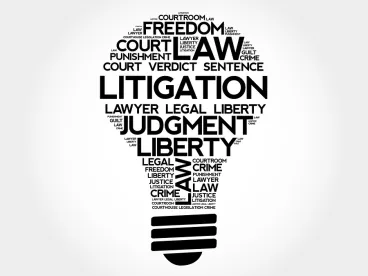When a patent claims an invention directed toward a combination of previously known elements, evidence that the combination produced unexpected results can often play a critical role in rebutting a challenge to the patent’s validity based on obviousness. On August 1, 2017, in Honeywell International Inc. v. Mexichem Amanco Holdings S.A. DE C.V., the Federal Circuit rejected a Patent Trial and Appeal Board obviousness determination that failed to properly consider such evidence in two merged inter partes reexaminations. No. 2016-1996, slip op. (Fed. Cir. Aug. 1, 2017).
The patent claims at issue were directed toward the combination of a known refrigerant (HFO-1234yf) with a known polyalkylene glycol (PAG) lubricant in heat transfer systems, such as air conditioning equipment. In support of the patentability of the claims, the patentee argued that HFO refrigerants were disfavored at the time of the invention by those of skill in the art in that they were known to be reactive and unstable, and that PAG lubricants also were understood to be unstable. The combination, the patentee contended, resulted in an unexpectedly stable composition having environmentally-favorable characteristics and exhibiting other desirable properties, such as low toxicity, reactivity, and effectiveness.
The Board nevertheless concluded that the patent claims were invalid as obvious. First, it dismissed the patentee’s evidence regarding unpredictability and unexpected properties of the claimed combination as inherent and of non-patentable weight. Then, it later credited that evidence as persuasively establishing unpredictability in the art and dismissed the evidence for other reasons—namely, because of the unpredictability as to stability of the claimed combination, routine testing would have led to its discovery. The Federal Circuit found the Board’s analysis to be internally inconsistent and individually flawed.
The Federal Circuit’s critique of the Board’s reasoning began by reemphasizing that the “use of inherency in the context of obviousness must be carefully circumscribed.” Honeywell, slip op. at 10. “What is important regarding properties that may be inherent, but unknown, is whether they are unexpected,” the Federal Circuit elaborated. Id. This is because, according to the Court, “[a]ll properties of a composition are inherent in that composition, but unexpected properties may cause what may appear to be an obvious composition to be nonobvious.” Id. The Federal Circuit therefore concluded that the Board erred as a matter of law “in dismissing properties of the claimed invention as merely inherent, without further consideration as to unpredictability and unexpectedness.” Id. at 11.
Next, the Federal Circuit criticized the Board for “reverse reasoning” in making “what amounts to a finding that one of ordinary skill would not have expected success, because [the patentee’s] evidence persuasively established the ‘overall unpredictability’ in the art, but then gloss[ing] over that finding with a ‘routine testing’ rationale because [the patentee] did not persuasively prove an expectation of failure.” Honeywell, slip op. at 12-13 (emphasis in original). As the Federal Circuit further explained:
Unpredictability of results equates more with nonobvious rather than obviousness, whereas that which is predictable is more likely to be obvious. Thus, reasoning that one would no more have expected failure than success is not a valid ground for holding an invention to have been obvious. The Board erred in so holding.
Id. at 13. In addition, the Federal Circuit further noted that 35 U.S.C. § 103 provides that “[p]atentability shall not be negated by the manner in which the invention was made,” and that the provision “was enacted to ensure that routine experimentation does not necessarily preclude patentability.” Id.
Ultimately, the case was remanded for the Board to make determinations consistent with the Federal Circuit’s opinion because the issue of motivation to combine with a reasonable expectation of success and consideration of objective evidence presented questions of fact. But it is a great example of the important role that unexpected results can play in evaluating obviousness, particularly in the context of patents claiming new combinations of previously known elements.
Other Notable Decisions – Week Ending August 4, 2017
Enzo Biochem Inc. v. Applera Corp., No. 2016-1881 (Fed. Cir. Aug. 2, 2017) (non-precedential): In Enzo, the Federal Circuit affirmed a district court’s summary judgment of no infringement under the doctrine of equivalents. In doing so, the Federal Circuit emphasized three important tenets of its doctrine of equivalents infringement jurisprudence: (1) “the concept of equivalency cannot embrace a structure that is specifically excluded from the scope of the claims”; (2) it cannot “render a claim limitation inconsequential or ineffective”; and (3) if it “would entirely vitiate a particular claim element, partial or complete judgment should be rendered by the court.” The claim language at issue, as properly construed, was limited to a method of “indirect detection” of a particular DNA or RNA sequence in a sample, and the Federal Circuit concluded that, under the above tenets and in the context of the claims at issue, “direct detection cannot be an equivalent of indirect detection.”
Homeland Housewares, LLC v. Whirlpool Corp., No. 2016-1511 (Fed. Cir. Aug. 4, 2017) (precedential): In Homeland, the Federal Circuit reversed a Patent Trial and Appeal Board finding of no anticipation in an inter partes review proceeding. First, the Federal Circuit found error in the Board’s claim construction and adopted a definition not proposed by either party. The Federal Circuit reasoned that it was not procedurally improper for it to adopt an alternative construction on appeal, in part, because the construction was “not new, but simply represent[ed] a midpoint between the two opposing constructions” advanced by the parties. The Federal Circuit then rejected the patentee’s unrebutted expert testimony presented on the issue of anticipation as “plainly inconsistent with the record” and “based on an incorrect understanding of the claims.” “A court should discount any expert testimony that is clearly at odds with . . . the written record of the patent,” the Federal Circuit instructed.




 />i
/>i

